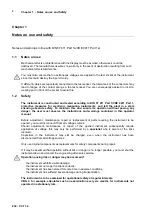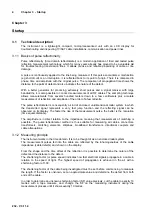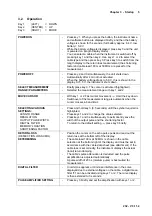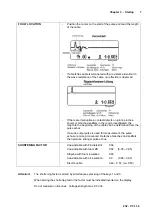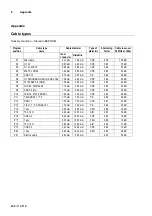
Chapter 1 - Notes on use and Safety
232 - V 3.11.4
2
Chapter 1
Notes on use and safety
Notes and warnings in line with DIN 57 411 Part 1a/VDE 0411 Part 1a
:
1.1
Notes on use
Mechanical effects on/interference with the display must be avoided, otherwise it could be
destroyed. The manufacturer assumes no warranty in the event of destruction resulting from such
mechanical effects/interference.
You must also ensure that no extraneous voltages are applied to the test socket of the instrument,
since this could destroy the input circuitry.
If different cables are repeatedly connected to the test socket, the tolerances of the connectors may
lead to fatigue of the contact springs in the test socket. You are consequently advised to insert a
wearing part in front of the socket to avoid this.
1.2 Safety
The instrument is constructed and tested according to DIN 57 411 Part 1/VDE 0411 Part 1,
protective measures for electronic measuring instruments, and left the plant in a state
ensuring absolute safety. To maintain this and ensure its operation without posing any
danger, the user must observe the instructions and warnings contained in this operator
manual.
Before adjustment, maintenance, repair or replacement of parts requiring the instrument to be
opened, you must disconnect it from all voltage sources.
Should adjustment, maintenance or repair of the opened instrument subsequently require
application of voltage, this may only be performed by a
specialist
who is aware of the risks
involved.
Capacitors in the instrument may still be charged, even when the instrument has been
disconnected from all voltage sources.
Only use original components as replacements for safety components during repair.
If it may be assumed that operation without risk or danger is no longer possible, you must shut the
instrument down and contact the engineering after-sales service.
Operation posing risk or danger may be assumed if
-
the instrument exhibits visible damage,
-
the instrument no longer functions correctly,
-
the instrument has been stored for some time in adverse conditions,
-
the instrument has suffered severe damage during transportation.
The instrument is to be examined for operational safety at regular intervals.
VBG 4, for example, stipulates such an examination every six months for instruments not
operated in a stationary role.


